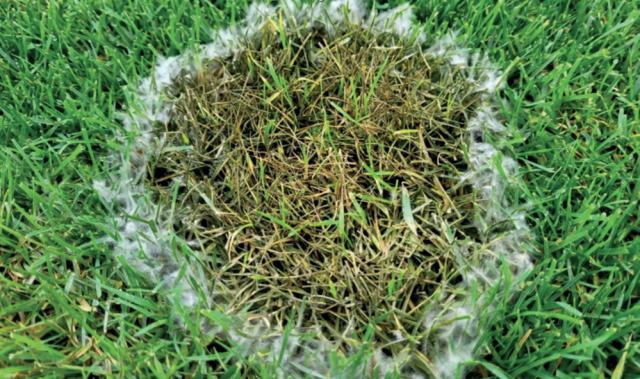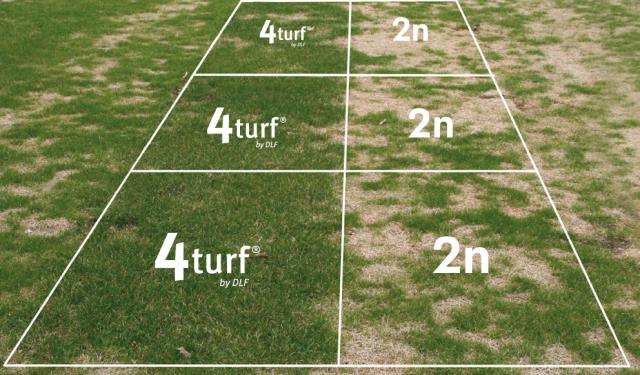
Turf from DLF: Stronger Against Microdochium
Climate change will increase the risk of Microdochium patch outbreaks in many parts of Europe. Warmer autumns and milder winters, combined with prolonged leaf wetness, higher humidity, and frequent rainfall, create ideal conditions for the disease to thrive. At the same time, turfgrass is under more stress due to fluctuating weather patterns, including sudden freezes, drought periods, or heavy rains. These conditions reduce the turf’s natural resilience and increase its susceptibility to disease. As a result, turf managers will face more severe and extended disease pressure in areas where it was once manageable, making the use of resistant 4turf® varieties and proactive management strategies increasingly important.
What is Microdochium patch?
Microdochium patch, also sometimes referred to as pink snow mold or fusarium patch, is a fungal disease caused by Microdochium nivale. It becomes active during cool, wet periods, particularly from late autumn through early spring. The disease is most seen on close mown turf, such as golf greens and winter sports fields. It begins as small, water-soaked patches that gradually expand and merge, forming irregular areas that range in color from brown to pinkish or tan. When conditions are moist, especially during the early morning or under snow cover, the affected areas may show a layer of white to pink fungal growth known as mycelium.
Microdochium patch can sometimes be confused with grey and speckled snow mold, both diseases that require snow cover over an extended duration, but a distinctive identifier of Microdochium patch is the pinkish ring that often forms around the edges of the affected grass. In addition, the fungus causing Pink snow mold does not produce sclerotia in diseased leaf material, i.e. small compact masses of mycelium.
Screening method
To ensure resistance in our novel DLF varieties our breeders are selecting only the best performing single plants for crossings to new varieties. To support this, we have built a high throughput screening platform where we can reliably screen thousands of single plants each year. A major concern of disease trials under natural conditions is the inhomogeneous spread of the disease; one plant might be under much higher disease pressure than another, and this can lead to false readings. This problem is mediated through precise inoculation under controlled conditions. An essential part of the development was to validate our results from our screening in controlled conditions to what happens under natural conditions.
This guarantees that our new varieties will offer excellent genetic resistance to our customers. DLF also screens turfgrass varieties for Microdochium patch resistance under natural infection pressure. Our testing locations, in especially Denmark and the Netherlands, offer ideal conditions for field screening, with high natural disease pressure through autumn, winter and spring. In addition to in-house trials, Microdochium resistance is evaluated through independent national lists, such as the Scanturf/Scangreen list and the French list, which ranks varieties by performance under disease pressure.

Microdochium problems
Microdochium patch is one of the most damaging and persistent turfgrass diseases in cool, temperate regions. It is especially problematic on high maintenance turf such as golf greens, sports pitches, and ornamental lawns, particularly in autumn, winter, and early spring. The disease primarily affects perennial ryegrass (Lolium perenne), annual meadowgrass (Poa annua), and bentgrasses (Agrostis spp.). The disease typically develops when temperatures are between 0 and 10°C.
It is also encouraged by high nitrogen levels in late autumn, which promote soft, lush growth that is more vulnerable to infection. Turf cut very short—below 5 millimeters—is at greater risk, especially when poor drainage, shade, and soil compaction are present. These conditions are commonly found in northern and western Europe, including countries like the UK, Germany, the Netherlands, and across Scandinavia. Certain turfgrass species, particularly Poa annua and Agrostis stolonifera, are naturally more susceptible to the disease.
Photo shows pink snow mold attack at breeding station in Denmark
Screening results
4turf® varieties are more resistant to Microdochium patch compared to diploid perennial ryegrass.
Screening results
4turf® varieties are more resistant to Microdochium patch compared to diploid perennial ryegrass.